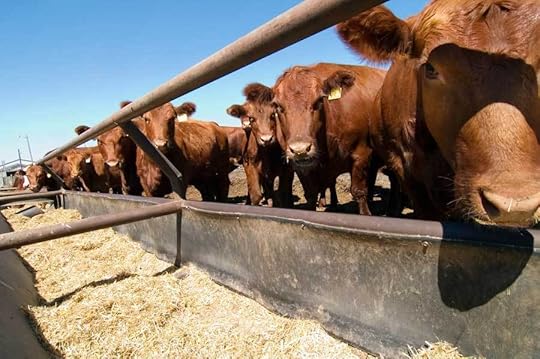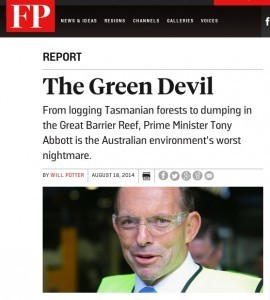Will Potter's Blog, page 7
September 27, 2014
BREAKING: 4 People Prosecuted Under #AgGag Law for Photographing Factory Farm From the Road
 Circle Four Farms sprawls across 90 square miles of land in southwestern Utah. There are about 600,000 hogs here at a time, packed by the thousands into long warehouse sheds. About one million hogs—185 times the human population of the county—are raised at Circle Four each year, making it the largest factory farm in the state; its parent company, Smithfield Foods, is one of the largest in the world.
Circle Four Farms sprawls across 90 square miles of land in southwestern Utah. There are about 600,000 hogs here at a time, packed by the thousands into long warehouse sheds. About one million hogs—185 times the human population of the county—are raised at Circle Four each year, making it the largest factory farm in the state; its parent company, Smithfield Foods, is one of the largest in the world.
The farm is so large that its scale is difficult to view from the public road. At best, one could see a few of the sheds, some feed bins, trucks.
But Circle Four Farms has plenty of reasons to be wary of exposure, even from a distance. The company came under scrutiny earlier this month by the USDA because of a deadly pig virus. Last year, it was part of a controversial financial deal—the largest-ever Chinese takeover of a U.S. company. Public health studies have shown that people who live near the farm are much more likely to be hospitalized, for a wide-range of illnesses. And the farm has also been investigated by the Justice Department as part of the largest-ever case of human trafficking.
So it is perhaps not surprising that when farm employees saw people driving by on Wednesday, September 24th, and taking photographs, they reacted quickly. They followed the two cars, stopped them, demanded that they turn over their photos and, when they refused, called the sheriff.
Four animal rights activists had driven to Circle Four Farms on Wednesday, September 24th, to wait for slaughterthouse-bound trucks leaving the facility. They were going to photograph and videotape the transport for a national non-profit group called the Farm Animal Rights Movement. The photography was part of a series of efforts by FARM leading up to World Day for Farmed Animals on October 2nd.
When they were waiting for the trucks, one of the activists, Sarah Jane Hardt, photographed the farm from the street. The photographs, included here, capture the rows of sheds and the barren landscape, but not much detail of the farm.
much detail of the farm.
When they set off down the road again, that’s when Circle Four Farms trucks pulled in front of them and stopped them.
The workers repeatedly asked to see the cameras, said Bryan Monell, one of the activists. “He was asking, ‘Have you ever heard of PETA? Are you a member of the Animal Liberation Front? After a while they just let us pass,” Monell said.
Before the group had reached Utah State Highway 21, though, they were pulled over by the Beaver County Sheriff’s Department.
The police officer immediately started talking to them about Utah’s ag-gag law and the Animal Enterprise Terrorism Act, Monell said.
“He was really adamant about getting hold of our photographs,” Monell said. “He said, ‘There’s a thing called ag-gag out here. I’m not going to say whether I support it or not, but it’s serious. They don’t take kindly to that stuff out here.'”
As officers questioned the group, employees from Circle Four Farms were nearby urging their arrest. “At one point [the employees] started telling the cops that we broke through a barn door and were running through the sheds,” Monell said. “That’s just crazy.”
 They were detained for about five hours, they say. Eventually, after repeatedly refusing to turn over their photographs or allow the police to search their cars, they were each given two citations. One for criminal trespass, the other for “agricultural operation interference,” or violating Utah’s ag-gag law.
They were detained for about five hours, they say. Eventually, after repeatedly refusing to turn over their photographs or allow the police to search their cars, they were each given two citations. One for criminal trespass, the other for “agricultural operation interference,” or violating Utah’s ag-gag law.
It’s only the second time that an ag-gag law has been enforced, nationally. The first time was also in Utah. A young woman named Amy Meyer saw a sick cow being pushed by a bulldozer, and she filmed it from the public street. After a news report on this website about her prosecution went viral, prosecutors dropped all charges.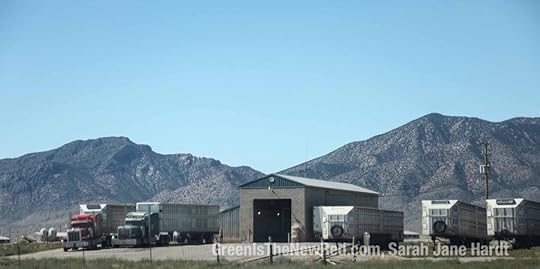
Utah is one of seven states to enact ag-gag laws that make it illegal to photograph factory farms and slaughterhouses. The laws are a direct response to a series of undercover investigations by animal welfare groups exposing horrific animal cruelty.
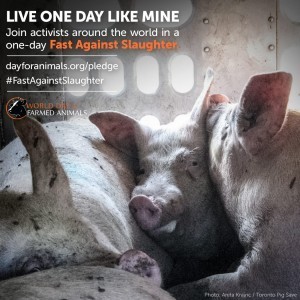 Right now ag-gag laws are being challenged in court as unconstitutional in Utah. A similar lawsuit in Idaho has the support of 16 different professional journalism organizations along with food safety, whistleblower, and consumer groups.
Right now ag-gag laws are being challenged in court as unconstitutional in Utah. A similar lawsuit in Idaho has the support of 16 different professional journalism organizations along with food safety, whistleblower, and consumer groups.
The activists said that as they were detained, and police officers were talking about felonies and terrorism charges, they had no idea what to expect.
“I really thought I was going to be talking to you from a jail payphone,” Monell said.
BREAKING: 4 People Prosecuted Under #AgGag Law for Photographing Factory Farm From the Road from Green Is The New Red
September 26, 2014
#AgGag Victory in Australia!
 A U.S.-style “ag-gag” proposal to restrict undercover investigations has just been defeated in South Australia.
A U.S.-style “ag-gag” proposal to restrict undercover investigations has just been defeated in South Australia.
The Surveillance Devices Bill would have cracked down on undercover investigations—particularly those by animal rights groups—by criminalizing the publication of undercover video.
Activists and journalists would have faced a $15,000 fine or imprisonment of three years. Organizations involved in the investigations would face a maximum penalty of $75,000.
It was strongly opposed by animal protection groups such as Voiceless, and also media organizations and labor unions.
[Photo by Jo-Anne McArthur, We Animals]
“The concerns with this bill were held by both the media and also civil society advocates for whether it was animal rights or consumer affairs,” Greens MLC Tammy Franks said.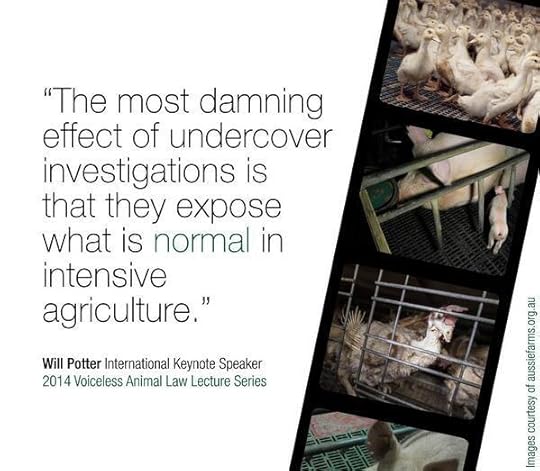
The proposal was similar to U.S.-style “ag-gag” bills promoted by the agriculture industry to stop the negative publicity created by covert undercover video of animal cruelty.
The bill did not explicitly focus on slaughterhouses or factory farms, but Minister Gail Gago noted when it was introduced that animal activists were central to the debate.
Ag-gag has been a growing debate in Australia within the last year. I recently completed a month-long tour about ag-gag laws there, and the media and public response to the bills was overwhelmingly against them.
The defeated of this proposal in South Australia is a major victory. But more ag-gag proposals are being concerned at the state and federal level.
“The (Victorian) Government has been considering workable measures that can be introduced to give legitimate farming business protection against unlawful activism,” a spokeswoman for Agriculture Minister Peter Walsh said.
September 18, 2014
The Animal Enterprise Terrorism Act and the Criminalization of Dissent
“Terrorization of Dissent: Corporate Repression, Legal Corruption, and the Animal Enterprise Terrorism Act” is a new book examining the AETA and how it threatens the right to protest.
The following is from the preface by Will Potter:
When I testified before the U.S. House Judiciary Committee about the Animal Enterprise Terrorism Act in 2006, I argued that such sweeping legislation criminalizes First Amendment activity, whistleblowing, and nonviolent civil disobedience as “terrorism,” and would have a chilling effect on free speech. Members of the committee, including Rep. Bobby Scott (D-VA) and Rep. James Sensenbrenner (R-WI), dismissed my concerns and promised that the law would only target property destruction and violence.
This has been the major talking point from supporters of this legislation for years: the law is only about “extremists,” and as long as you aren’t part of the Animal Liberation Front, you have nothing to worry about. Lawmakers went so far as to respond to my concerns by including empty rhetoric in the rules of construction promising that the bill “does not include any lawful economic disruption (including a lawful boycott) that results from lawful public, governmental, or business reaction to the disclosure of information about an animal enterprise.”
Since that time, the true scope of this legislation has been exposed by prosecutions, uncovered FBI documents, and new campaigns by industry groups. It has become undeniably clear that members of Congress were either duped by corporations and the FBI or they intentionally lied to the American people about their intentions. The true targets of the AETA are not arsonists or underground activists. Instead, the people most at risk are undercover investigators and aboveground activists.
The very first AETA arrests were four animal rights activists in California who were never accused of property destruction or violence. The government argued that their conduct—which included “chalking defamatory slogans,” protesting while wearing masks, distributing fliers, and attending a home protest—amounted to a campaign of terrorism. In a major blow to the government’s overzealous use of the new law, a U.S. District Court threw out the indictment because prosecutors did not clearly explain what, exactly, the protesters did. “In order for an indictment to fulfill its constitutional purposes, it must allege facts that sufficiently inform each defendant of what it is that he or she is alleged to have done that constitutes a crime,” Judge Ronald M. Whyte’s said in his ruling. “This is particularly important where the species of behavior in question spans a wide spectrum from criminal conduct to constitutionally protected political protest.”
Even more disturbing is the fact that the FBI Joint Terrorism Task Fce has kept files on activists who expose animal welfare abuses on factory farms and has recommended prosecuting them as terrorists. This information was revealed in documents that were uncovered through the Freedom of Information Act (FOIA) and has been reported on my website, GreenIsTheNewRed.com. The 2003 FBI file details the work of several animal rights activists who used undercover investigation to document repeated animal welfare violations. The FBI special agent who authored the report said they “illegally entered buildings owned by [redacted] Farm . . . and videotaped conditions of animals.” The animal activists caused “economic loss” to businesses, the FBI says. And they also openly rescued several animals from the abusive conditions. This was not done covertly in the style of underground groups like the Animal Liberation Front; instead, it was an act of nonviolent civil disobedience and, as the FBI agent notes, the activists distributed press releases and conducted media interviews taking responsibility for their actions.
Based on these acts—trespassing in order to photograph and videotape abuses on factory farms—the agent concludes that there “is a reasonable indication” that the activists “have violated the Animal Enterprise Terrorism Act, 18 USC Section 43 (a).” The file was uncovered through a FOIA request by Ryan Shapiro, a doctoral candidate at MIT who is one of the activists mentioned as being in violation of the law. “It is deeply sobering to see one’s name in an FBI file proposing terrorism charges,” Shapiro told me. “It is even more sobering to realize the supposedly terroristic activities in question are merely exposing the horrific cruelty of factory farms, educating the public about what goes on behind those closed doors, and openly rescuing a few animals from one of those farms as an act of civil disobedience.”
The FBI file, it should be noted, was dated 2003. That is three years before the Animal Enterprise Terrorism Act was passed. In other words, the FBI argued that such prosecutions were possible under the previous and narrower version of the law. If that was the case, why was the AETA even necessary?) The FBI knew that the existing law was already vague and overly broad, but joined industry groups in grasping for even more power. In recent years a legislative trend has developed that, prior to the AETA, I never would have thought possible. More than a dozen states have considered legislation that explicitly criminalizes undercover investigations by nonprofit animal welfare groups like the Humane Society and Mercy for Animals. At the time of this writing, Iowa and Utah have passed “Ag Gag” bills into law, and others are expected to follow.
These investigations have exposed systemic animal cruelty at factory farms, and completely changed the national dialogue about animal agriculture. The video footage has led to criminal convictions in Iowa, voter referendums in Florida, and consumer outrage at the most egregious animal welfare abuses. The threat that they pose to factory farming is unmistakable.
When a California slaughterhouse was shut down for egregious animal welfare violations, industry groups put pressure on Congress. Three lawmakers then sent a letter to the USDA urging the department to take action against “the onslaught of attacks” by animal welfare groups.
This is the political climate since the passage of the AETA. In the years after it was signed into law, industry groups and law enforcement have only grown more ambitious. There has been a widening of the net, which risks ensnaring more and more activists as “terrorists.” Such repression of political activists is certainly not new; for instance, the FBI used both legal and illegal tactics against civil rights, antiwar, and other activists during COINTELPRO in the 1960s. But in post-9/11 America, the power of “terrorism” rhetoric, combined with corporate efforts to manufacture and manipulate government repression, has created a unique and incredibly powerful culture of fear.
However, the political climate within the animal rights movement has changed as well.
During the 2006 hearing, I testified as the only opposing witness. The vast majority of activists were completely unaware of the legislation, and most organizations were unwilling to speak up about it. This chilling effect still exists, in many ways, but the movement’s response has radically changed. The Center for Constitutional Rights is challenging the Animal EnterpriseTerrorism Act on behalf of activists who have felt silenced. A diverse coalition of animal, environmental, civil liberties, and legal organizations is fighting Ag Gag bills across the country.
This current collection of essays—written by activists, lawyers, and scholars, and finely edited by Jason Del Gandio and Anthony J. Nocella II—adds critical voices to the growing chorus of opposition. It should be viewed not as a historical examination, but as a contemporary toolkit. The authors chart the legal and political history of the law and include the personal stories of those affected. These texts should be read with the understanding that this repression is dynamic. The AETA, as a legal-and-corporate tactic, is expanding to other social movements, and it is evolving as it appears internationally: Corporations have ushered in nearly identical crackdowns in Austria, Spain, Finland, and many other countries.
This book is a toolkit not just for animal rights activists, but for all social movements around the world who are effectively challenging corporate power, and who want to better prepare themselves for the backlash that is an inevitable part of that struggle.
Order your copy today!
The Animal Enterprise Terrorism Act and the Criminalization of Dissent from Green Is The New Red
September 15, 2014
Agriculture Official Who Called #MeatlessMonday “Treasonous” Is Back At It
 The state Agriculture Commissioner for Texas is warning the public of an insidious plot to indoctrinate our children. And it could be coming to a school cafeteria near you.
The state Agriculture Commissioner for Texas is warning the public of an insidious plot to indoctrinate our children. And it could be coming to a school cafeteria near you.
“This activist movement called ‘Meatless Mondays‘ is a carefully-orchestrated campaign that seeks to eliminate meat from Americans’ diets seven days a week — starting with Mondays,” Ag Commisioner Todd Staples wrote in a recent op-ed for the Austin American-Statesman.
The Dripping Springs school district, outside of Austin, adopted the program recently. It’s part of a growing national trend to offer healthier, more sustainable meals just one day a week.
But Staples says its part of a radical activist agenda by groups like the Humane Society. (The reality is that the program was started by Johns Hopkins Bloomberg School of Public Health a decade ago).
That kind of hyperbole isn’t surprising coming from Staples. This is the same guy who previously called the Meatless Monday program “treasonous.” He also said that USDA employees who have promoted it are “the enemy” and should be fired.
Why such hostility to Meatless Mondays? Well Staples has received at least $116,000 in campaign contributions from beef and ranching interests since 2010, according to public records. And this treasonous rhetoric is identical to that of the meat industry; just a few days ago I reported on Beef Magazine comparing the Humane Society to ISIS.
The registered dietitian who introduced the program in Dripping Springs says it was in response to growing body of research supporting vegetarian diets. He said parents were asking for veggie options.
Well, except for one outraged parent. The meatless menu was brought to the attention of Staples by an angry mom who—wait for it—just happens to work for the ag industry.
As Asher Price at the Statesman reported, Leah Wilkinson’s family is in the pork industry and she personally works in the animal-feed industry.
Her job? Government relations.
Agriculture Official Who Called #MeatlessMonday “Treasonous” Is Back At It from Green Is The New Red
September 12, 2014
Beef Industry Compares the Humane Society to ISIS
You’ve probably heard a lot about ISIS in the news lately, primarily connected with the group’s beheadings of Americans and journalists.
Beef Magazine is warning readers that this type of violence isn’t limited to the Middle East, though. There’s a similar group operating right here on U.S. soil: the Humane Society.
Troy Marshall writes that jihadist groups like ISIS have defenders who try to obscure their hate to make their message more acceptable. “On a similar note,” he says, “Wayne Pacelle, the president and CEO of The Humane Society of the United States (HSUS), has made his intentions clear, too…
“The terrorists are dangerous no doubt, but they tend toward a naiveté that almost ensures their ultimate defeat. HSUS, on the other hand, is extremely sophisticated in its attacks. HSUS attacks on many fronts. It uses legislation and public policy where possible; the judicial system to sue people into submission; has a huge public relations machine to blackmail businesses to fall in line; and effectively wields the ballot initiative to circumvent the legislative and judicial branches when those avenues fail them.”
Beef has now removed the comparisons to ISIS from the column, but the original is still available online.
No matter how absurd this sounds, it’s far from the first time that factory farmers have compared the Humane Society to “terrorists.”
Recently the Center for Consumer Freedom (an industry front group) said that the Humane Society has the support of “terrorism moneymen” because HSUS VP Paul Shapiro was on Al Jazeera.
This is the same group that bought a full-page ad in the New York Times attempting to connect the Humane Society to terrorists. It even included a flow chart. (In response to that, we came up with a much more direct connection between the Center for Consumer Freedom and terrorists.)
And when they’re not using terrorism rhetoric, Big Ag is drawing inspiration from something just as fictional: Star Wars.
According to a recent column for Cattle Network, HSUS president Wayne Pacelle is just like General Grievous (the lightsaber-weilding menace from Star Wars Episode III: Revenge of the Sith).
Oh, and don’t forget these are the same folks who compared my new aerial photography project to the death star.
If anything, efforts like this reflect the ag industry’s desperation. They’re doing everything they can to avoid responding to consumer demand for more compassionate, sustainable agriculture.
That’s why they are pushing “ag-gag” laws that make it illegal to expose animal cruelty. That’s why they lobbied for laws like the Animal Enterprise Terrorism Act, which turns civil disobedience into terrorism if done in the name of protecting animals.
And that’s why they’ve expanded their terrorism rhetoric to the most mainstream, aboveground groups like the Humane Society.
Beef Magazine is right that animal advocates are increasingly becoming “extremely sophisticated.” Perhaps the industry should actually listen to what they have to say.
Beef Industry Compares the Humane Society to ISIS from Green Is The New Red
September 10, 2014
Great News in the Lawsuit Against Idaho’s #AgGag Law
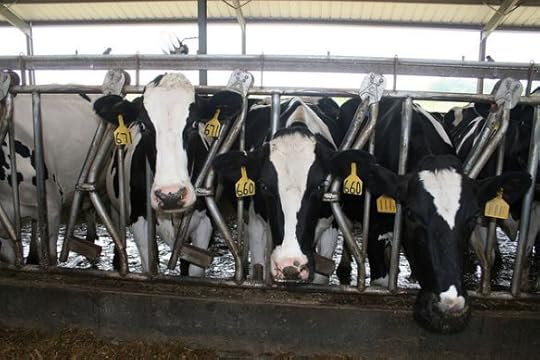 Idaho’s “ag-gag” law against photographing factory farms and slaughterhouses raises serious constitutional issues that need to be evaluated, a federal district court judge recently ruled.
Idaho’s “ag-gag” law against photographing factory farms and slaughterhouses raises serious constitutional issues that need to be evaluated, a federal district court judge recently ruled.
That means the lawsuit by the Animal Legal Defense Fund, ACLU of Idaho, PETA, undercover investigators and others (including me — I’m a plaintiff because ag-gag threatens journalists) is moving forward.
It’s a milestone in the case, and on top of that it’s an incredibly strong ruling.
Idaho was the 7th state to pass an “ag-gag” law, and it was in direct response to an undercover investigation by Mercy For Animals which exposed workers at Bettencourt Dairies punching and sexually abusing cows.
Idaho’s Section 18-7042 created a new crime called “interference with agricultural production” which criminalizes photography and undercover investigations at
agricultural production facilities.”
Ag-gag May Violate the First Amendment
The government argues that ag-gag doesn’t restrict First Amendment activity, because undercover investigators may misrepresent themselves on job applications in order to film.
Chief US District Judge B. Lynn Winmill said in his ruling that a ban on photography and videography is clearly a free speech issue. And if journalists or investigators lie on a job application, that’s still fully protected speech.
As an example, Judge Winmill cited union activity called “salting,” where unions send paid reps to apply for jobs so that they can recruit new union members. Because union organizers are often denied access to worksites, they have to lie or misrepresent themselves on job applications. Salting is completely legal, and it’s even protected by the National Labor Relations Act.
“Misrepresentations would be protected speech,” Judge Winmill said, “because they are not made to cause material harm to an agricultural production facility but to expose truths about the agricultural industry.”
Ag-gag May Violate the Equal Protection Clause
The plaintiffs argue that ag-gag laws are meant to single out animal rights activists and journalists for harsh penalties solely because they speak critically of the agriculture industry.
In other words, ag-gag creates a separate classification under the law “between whistleblowers generally and whistleblowers in the agricultural industry.”
Judge Winmill seems to agree, and says that ag-gag is neither content nor viewpoint neutral.
Under the law, it’s illegal to film animal abuse without permission, but it’s not illegal to film the farm owner’s children, he notes.
“Likewise, the law only prohibits unauthorized filming, so it is more likely that those who wish to portray the agricultural facility in a positive light will be allowed to film while those critical of the industry will not,” Judge Winmill writes. “By, in effect, privileging speech that is supportive of the agricultural industry, section 18-7042 impermissibly discriminates on viewpoint.”
Backlash against effective advocacy
Perhaps most important is that Judge Winmill acknowledged that ag-ag, at its core, is an attempt by the industry to stifle negative publicity by effective undercover investigators and the media.
“In fact, the more successful an activist is in mobilizing public opinion against a facility by publishing a video or story critical of the facility the more the activist will be punished,” he wrote.”
That point wasn’t lost on a recent editorial by the Idaho Statesman, which called ag-gag “misguided” and “overripe with spoiled-milk special interest meddling and influence that offer a nuclear solution to a conventional trespassing problem.”
The editorial board said that if the law is not overturned, lawmakers should be held accountable in the next legislative session:
“Because right now Idaho is in full ripeness as a state that looks like it has something to hide. And that is not a good place to be.”
Great News in the Lawsuit Against Idaho’s #AgGag Law from Green Is The New Red
September 8, 2014
13 Incredible Photos of Amazon Tribe Fighting Back Against Illegal Loggers
 Brazil is the most dangerous place in the world to be an environmentalist. It accounts for about half of all recorded killings of environmental advocates.
Brazil is the most dangerous place in the world to be an environmentalist. It accounts for about half of all recorded killings of environmental advocates.
And those numbers are going up, globally. As I reported recently for Foreign Policy:
Between 2002 and 2013, at least 908 people were killed because of their environmental advocacy, according to “Deadly Environment,” a new report from the investigative nonprofit Global Witness. That’s an average of at least one environmentalist murdered every week, and in the last four years, the rate of the murders has doubled. In 2012, the deadliest year on record, 147 deaths were recorded, three times more than a decade earlier. “There were almost certainly more cases,” the report says, “but the nature of the problem makes information hard to find, and even harder to verify.”
That incredibly dangerous environment makes what photographer Lunae Parracho documented even more incredible.
Parracho (website, Twitter, Flickr) followed the Ka’apor tribe, an indigenous community in Brazil, as they fought back against illegal loggers.
Ka’apor warriors ventured into the Alto Turiacu territory in the Amazon basin to track down illegal loggers, tie them up, and sabotage their equipment.
They stole their chainsaws and cut the logs so the loggers couldn’t profit from them.
They released the loggers, but only after taking their shoes and clothes, and setting their trucks on fire.
13 Incredible Photos of Amazon Tribe Fighting Back Against Illegal Loggers from Green Is The New Red
September 2, 2014
Tasmania’s “Protection From Protesters” Bill Is As Bad As It Sounds
 It could soon become illegal to protest logging, fracking, or any issue in Tasmania if it may “impede or obstruct the carrying out of business activities.”
It could soon become illegal to protest logging, fracking, or any issue in Tasmania if it may “impede or obstruct the carrying out of business activities.”
The “Workplaces (Protection From Protesters) Bill” is a direct response to environmentalists protesting the logging of Australia’s ancient forests. The Liberal Party made campaign promises that they would protect the logging industry and shut down protesters, and now they’re trying to follow through.
The bill includes on-the-spot fines of up to $10,000, and a mandatory three-month jail sentence for second offenses. It would be the first time mandatory sentences have ever been imposed in Tasmania.
And any organizations that “incite or encourage this illegal behaviour” could be fined up to $100,000.
Supporters of the bill say it’s about “extremists” and “terrorists,” but the primary targets are protesters using non-violent civil disobedience to blockade logging roads and halt clearcutting operations.
As former Green Party leader Bob Brown said: “These laws would have jailed Gandhi and Jesus Christ himself.”
 The bill doesn’t just target environmentalists, though. It is written so broadly that it could be used against a wide range of protest activity.
The bill doesn’t just target environmentalists, though. It is written so broadly that it could be used against a wide range of protest activity.
“There is a high risk of capturing individuals who would not in any sense be characterized as ‘extremist’,” wrote Senior Counsel Greg Melick in a 36-page report he was asked to prepare for the government.
“Even if the legislation is successful is curbing disruption to business activity by protesters, it is likely to be disproportionate in its effects.”
The report identified hypothetical cases that could be prosecuted under the bill, such as a farmer who would not allow a fracking company to enter his property.
That was enough for the Tasmanian Farmers and Graziers Association to turn against the bill. And unions are concerned that they would be affected as well.
There are already existing laws that cover the scope of this legislation. It’s illegal to trespass or harass, for example. So why make some actions more illegal if done by protesters?
Because this is part of a broader campaign by Abbott’s Liberal Party to roll back environmental protections and cut “green tape” for corporations. As I reported recently for Foreign Policy, these are the same people who support logging in World Heritage protected sites, and dumping dredged soil in the Great Barrier Reef.
The bill was passed by Tasmania’s Lower House in late June, and the Upper House is expected to consider it in October.
But it won’t become law without a fight. Hobart, Tasmania is a quiet town, and often seen as friendly to the logging industry — but more than 500 people come out recently in protest.
Still Falling from Burning Hearts Media on Vimeo.
Tasmania’s “Protection From Protesters” Bill Is As Bad As It Sounds from Green Is The New Red
August 25, 2014
I’ll be giving the keynote at this year’s Animal Law Conference
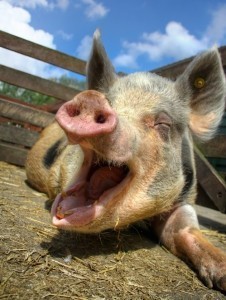 I’m excited to announce that I’ll be giving the keynote address at the 2014 Animal Law Conference, which is coming up in October at Lewis & Clark Law School.
I’m excited to announce that I’ll be giving the keynote address at the 2014 Animal Law Conference, which is coming up in October at Lewis & Clark Law School.
This is the 22nd year of the conference, which has become the most important of its kind within the global animal law community.
I’ll be speaking about ag-gag laws, and fighting back against them.
The conference is nearly fully-booked, so if you haven’t signed up already, please do!
I’ll be giving the keynote at this year’s Animal Law Conference from Green Is The New Red
August 19, 2014
The Green Devil: Tony Abbott is an environmental nightmare
My latest article for Foreign Policy.
Hiking through the Tasmanian wilderness feels like a scene out of Jurassic Park. Overhead are the tallest flowering trees on the planet. Underfoot are so many layers of damp, mossy growth that, without stepping carefully, a boot could crunch right through. The Tasmanian devil lives here, and so do the platypus and wedge-tailed eagle; some Huon pine trees here are more than 2,000 years old. Located at the bottom of the world, Tasmania is a bioregion so unique that it is listed as a World Heritage site by the United Nations for “outstanding universal value.” It satisfies more criteria for that designation than any other World Heritage site on Earth.
But for Australian Prime Minister Tony Abbott, this remarkable natural legacy isn’t worth protecting. Instead, it should be stripped.
Soon after being elected in September 2013, Abbott started making plans to fulfill his campaign promise of removing some environmental protections on Tasmania’s forest and opening it to industry, specifically logging. In March, he invited loggers to Australia’s Parliament House and told them that members of the country’s Green party were “the devil” and that “the environment is meant for man.” The loggers were thrilled.
A few months later, however, Abbott had to convince a different audience of his proposal — and this time, the response was not enthusiastic. When the World Heritage Committee of the United Nations Educational, Scientific and Cultural Organization (UNESCO)met in Doha in June 2014, it unanimously rejected Abbott’s plan to remove 74,000 hectares of Tasmanian forest from its list of cherished sites. One delegate said the move would have set an “unacceptable precedent.” The decision took less than 10 minutes.
It was a victory for the environmental community, in Australia and globally, but the international embarrassment didn’t deter Abbott. As one World Heritage site was ostensibly spared, he was already setting his sights on another: He wants to dump millions of tons of dredged soil from a coal-port expansion into the Great Barrier Reef.
When asked about Abbott, Greenpeace Australia Pacific CEO David Ritter responds with a mixture of laughter and exasperation. “My daughters are 5 and 2 years old,” Ritter says. “I have no idea how I am going to explain to them that, when they were children, the government of their country allowed this to happen to the Great Barrier Reef.”
Ritter isn’t alone. Australia’s opposition leader, Bill Shorten, has called Abbott an “environmental vandal,” and university researchers have said his first year in office has been nothing but an “environmental train wreck.” This dates back to his very first day in office, when Abbott introduced legislation to repeal a carbon tax on Australia’s most polluting industries. Soon after, a document created by Abbott’s cabinet surfaced, stating that his administration would no longer tolerate “any measures which are socialism masquerading as environmentalism.”
Abbott’s critics are using Cold War rhetoric too. As Lyndon Schneiders, national director of Australia’s Wilderness Society, writes in an email, “The Australian Government is taking environment policy back to the 1950s.”
There have already been many battles, and casualties, in Abbott’s war on the environment. In addition to supporting logging and mining at World Heritage sites, the prime minister has ignored the recommendations of his country’s nonpartisan Climate Change Authority. He refused to send a delegate to the U.N. climate negotiations in Warsaw, Poland, last November. He has slashed $435 million in funding for the Australian Renewable Energy Agency, and heappointed Dick Warburton, a self-proclaimed climate change “skeptic,” to review the country’s renewable energy priorities. Meanwhile, Abbott’s federal environment minister, Greg Hunt, has approved cattle grazing in the Wonnangatta Valley, which is part of the Alpine National Park — a national heritage site.
On Aug. 14, Abbott’s chief business advisor, Maurice Newman, created a stir when he said climate science was “warming propaganda” and that the planet could be facing a dangerous period of global cooling. The Labor Party’s environment spokesman told the Guardian, “These kinds of comments would be laughable if he didn’t have the prime minister’s ear.”
For Abbott, all environmental regulations are merely “green tape” that hold back corporate profits. He has hacked away at that tape by gutting the Environment Protection and Biodiversity Conservation Act, the legislative process for determining whether a development project is environmentally safe. Instead oil, gas, and mining permits are now funneled to other agencies where they can get a green stamp.
Even animals aren’t safe from Abbott’s slash-and-burn campaign. A shark cull, intended to find and eradicate man-eating sharks, has already killed 68 tiger, great white, and bull sharks in a three-month trial. Great whites are an endangered species, so the Abbott government simply exempted the state of Western Australia from federal laws protecting them. Abbott has also abolished the Australian Animal Welfare Advisory Committee and cut funding for animal welfare initiatives.
To make sure no one can adequately challenge his dictums, Abbott has eviscerated federal funding for programs such as the Environmental Defenders Offices (EDO), independent legal centers that operate in the public interest. “Without the EDO legal services many Australians could not afford to get legal advice or mount a legitimate legal challenge against large companies or governments over major development projects which threaten their local communities and environment,” Sue Higginson, the principal solicitor with the EDO in New South Wales, said in a statement.
Abbott’s anti-environment stance has raised eyebrows around the world. Environmental author Bill McKibben has written that Americans who traveled abroad during George W. Bush’s administration should have sympathy for Australians right now: “[I]t’s not easy being citizens of countries run by international laughing stocks.” The comparison is apt: Like the Bush administration, Abbott chooses to ignore or undercut federal and international law when it doesn’t suit his interests.
Yet he has no qualms about using the law as a political hammer to quash the opposition: In Tasmania right now, Abbott’s Liberal Party government is backing a new bill explicitly drafted to stop environmental protesters. The Workplaces (Protection From Protesters) Bill is aimed at quelling those who “prevent, impede or obstruct the carrying out of business activities.” Mining and logging industries are mentioned by name, but the bill is written so broadly that it could cover nearly any business. It includes a sweeping list of prohibitions against “protest activity,” with fines up to $10,000 if demonstrations interrupt business — and mandatory prison sentences for a second offense.
“This anti-democratic bill undermines basic principles of free speech and civil society,” Miranda Gibson, an environmental activist and spokesperson for the group Still Wild Still Threatened, writes in an email. “The Liberals are clearly pushing this Bill in order to continue their assault on the environment free from scrutiny and criticism by the community.”
The legislation could pass by the end of August.
Abbott’s government has also spoken out in support of proposed laws to crack down on activists who photograph and videotape animal agriculture. These so-called “ag-gag” laws are modeled after similar efforts in the United States (currently being challenged in court). The primary industries minister of New South Wales has gone so far as to saythat protesters who film animal welfare abuses on farms are “akin to terrorists.”
When will the onslaught end? According to Bob Brown, a former senator and parliamentary leader of the Australian Greens, Abbott may very well be shooting himself in the foot with his nightmarish environmental policies — losing public confidence and, potentially, votes. “Abbott is a political glitch,” Brown says. “Young Australians are the key to his downfall. One poll showed that 97 percent of Australians aged between 18 and 24 opposed Abbott’s failed attempt to remove World Heritage status from the tallest flowering forests on Earth, in Tasmania, so that they could be logged.”
“Suddenly,” Brown adds, “it is becoming difficult to find anyone who will freely admit to voting for him.”
The Green Devil: Tony Abbott is an environmental nightmare from Green Is The New Red


